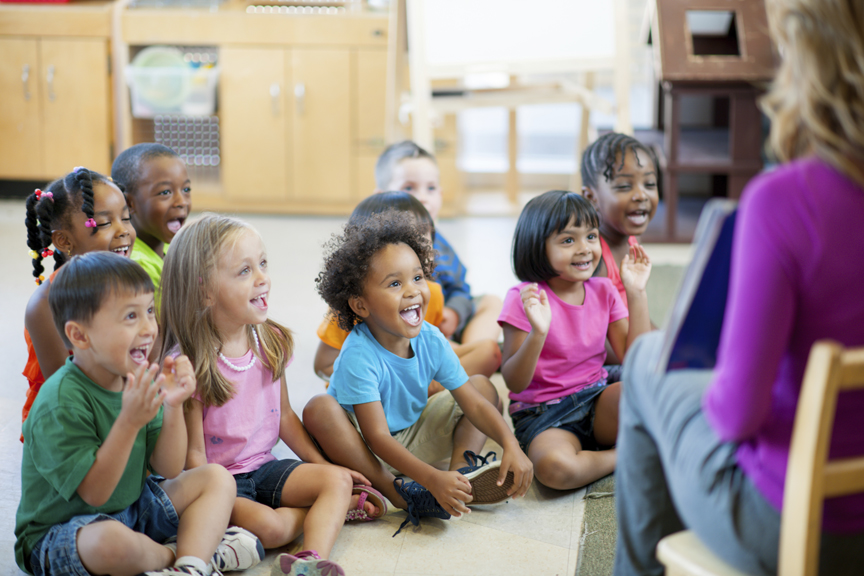- Behavior
- Education
- Health
Ages 5-6: Singing and dancing over so much amazing growth!

In this article, you’ll find answers to questions like:
1. Should all kids develop at the same rate?
2. What percentage of kids are at risk for delays?
3. Who can help?
Up to age 5 was a period of astonishing physical, emotional and social growth for your child. Although it may seem like your first-grader was just taking his first steps, he’s now mastered the monkey bars on the playground.
As parents, we often hear the term developmental milestones and know it’s important our children hit these markers at key moments of growth. But what exactly do child development specialists mean by that phrase?
1. SHOULD ALL KIDS DEVELOP AT THE SAME RATE?
“First, it’s important to remember that every child is an individual,” says Randee Gabriel, programs manager at 211 Palm Beach/Treasure Coast. “There are no two children that will hit every milestone at the exact same time. Still, there are crucial cues to look for at each age.”
Gabriel explains that children up to age 5 should reach milestones in how they play, learn, speak, act and move.
“This is because a young child’s brain develops incredibly quickly,” says Gabriel, adding the brain grows to 90 percent of its adult size by age 5.
Here’s some insight from the U.S. Centers for Disease Control and Prevention on what’s normal for your child’s development at these ages:
Age 5
|
years |
Balances on each foot for 10 seconds or longer; somersaults (tuck and roll); swings |
Copies patterns; prints some letters; cuts with safety scissors |
Recalls parts of a story; speaks in sentences of more than five words; names opposites |
Wants to please friends; more agreeable to rules; likes to sing, dance, act |
Age 6
Physical, social and mental skills develop quickly, and this is a critical time for children to develop confidence in all areas of life, such as through friends, schoolwork and sports.
- Showing more independence from parents and family
- Understanding more about their place in the world
- Paying more attention to friendships and teamwork
- Wanting to be liked and accepted by friends
- Demonstrating rapid development of mental skills
- Developing less focus on one’s self and more concern for others
2. WHAT PERCENTAGE OF KIDS ARE AT RISK?
One in four U.S. children up to age 5 are at moderate or high risk of developmental, behavioral or social delay, according to the U.S. Centers for Disease Control and Prevention. In addition, many children experience delays in language or other areas that can affect school readiness.
“Every age group brings within itself new changes and skills required,” Gabriel says. “While a child may have no concerns at 6 months, this does not guarantee there will be no concerns at 25 months or 48 months or beyond. Rescreening at each interval is imperative to identify these shifts and ensure healthy development over the long term.”
3. WHO CAN HELP?
Detection and intervention are critical for optimal outcomes for children. If you have questions or concerns about your child’s development, call 2-1-1 or chat online and ask for the Help Me Grow program. Help Me Grow services are free, including screenings, information and resource connection.
You can also call HomeSafe for a free screening at 561-383-9800.
SOURCES:
• Randee Gabriel, programs manager, 211 Palm Beach/Treasure Coast
• Centers for Disease Control and Prevention, U.S. Department of Health and Human Services
You May Also Like
-
- Behavior
- Health
- Parenting
How to help ease your child’s stress in elementary school
Does your kid seem overwhelmed? Start by helping your child identify stressful triggers, such as school situations or homework. Tap here to find out what else you can do. …
Read More -
- Behavior
- Health
- Parenting
Time to let go? Follow your child's lead to independence
When you start wondering if it’s time to let your children experience some things on their own, it’s best to assess their development instead of simply going by their age. Read on …
Read More -
- Education
- Health
- Parenting
My child's not keeping up with other kids! What should I do?
By ages 6 to 8, children’s vocabulary can increase to about 2,000 words or more. They’ll learn their left and right, begin to reason (and argue) using words like “why” and “because …
Read More
Related resources
-
- Behavior
- Education
- Health
211 Palm Beach Treasure Coast
Help Me Grow – information, guidance and developmental assessment of children up to age 8
2-1-1 Website Email -
- Education
- Parenting
School District of Palm Beach County
Exceptional Student Education — services for gifted students and students with special learning needs who have an individualized education program (IEP)
561-434-8740 Website -
- Education
- Parenting
Dyslexia, Learning and Support Group Florida
Helps parents and teachers navigate the community's resources to assist children with specific learning disabilities
561-601-5883 Website Email -
- Education
- Parenting
- Things to do
BRIDGES of Palm Beach County
Ten neighborhood hubs help parents raise children healthy, safe and strong
561-740-7017 Website -
- Education
- Safety
Achievement Centers for Children & Families
Child care, afterschool and family strengthening programs in Delray Beach
561-276-0520 Website Email
